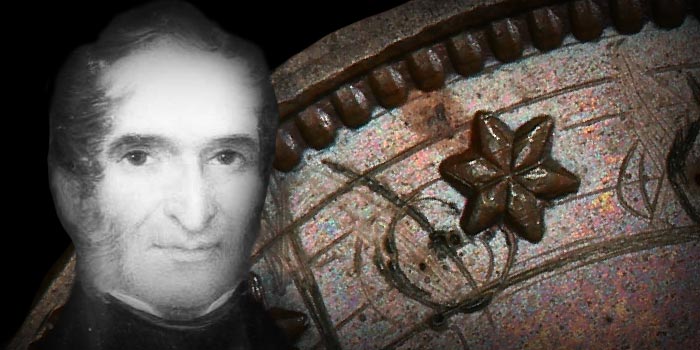A Window Into the Mind of Christian Gobrecht
By Rexford Goldbaum …..
Editor’s Note: This article originally appeared in Penny Wise, the official publication of Early American Coppers (EAC). Click here for more information about this vital organization for copper collectors.
* * *
In the absence of contemporary documentation denoting the details of issuance of early Proof Braided Hair cents (1839-1857), it has long been considered a possibility that several proof varieties of the type may have in fact been restrikes, perhaps created in the late 1850s alongside the backdated Proof half cents of that era.
For the years 1844 through 1849 in particular, all of the known Proof-only cent die varieties (by “Proof-only”, we mean that the dies used to strike them were not also used to strike coinage for use in circulation) display an identical irregularity upon the reverse rim, indicating that they were all struck using the same reverse die. From this, it has been inferred that Proofs of these years may have been struck simultaneously, after the dates they display.
As Proof-only varieties exist for other dates in the series, there has been some contention that they may have similarly been created at a later time, perhaps in order to fill holes for collectors[1].
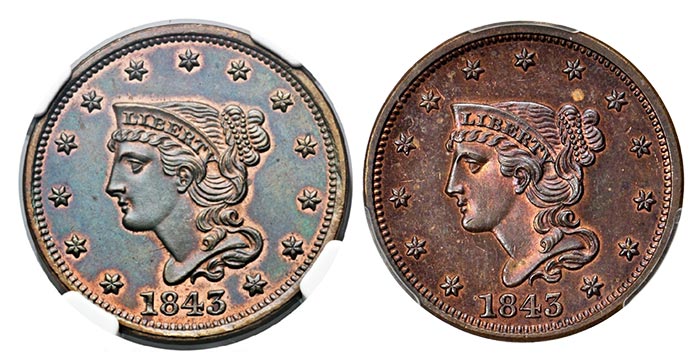
For the year 1843, two varieties of Proof cent exist: the Newcomb-14, which is struck from Proof-only dies, and the Newcomb-12, which shares dies with business strikes. As such, the Newcomb-14 has been suggested to be a later restrike, following the above argument. However, the recent discovery of an example of this variety that was undeniably struck within the year 1843 provides the very first piece of evidence we have that the variety was indeed an original striking, and as such may suggest that the Proof-only varieties apparent throughout the series are similarly contemporary to the dates they display, with the reverse die of 1844 through 1849 simply being retained and reused through the years.
Recently a coin came to my attention that, at first glance, appeared the victim of an array of unfortunate post-mint modifications, perhaps the engraving project of some unoccupied youth or of a metalworker honing his skills. Upon closer inspection, however, a markedly different story is revealed — one relating definitive intent, geometric exactitude, and admirable thoroughness – simultaneously a work of art in its own right and an incomparable insight into the design process of Chief Engraver Christian Gobrecht.
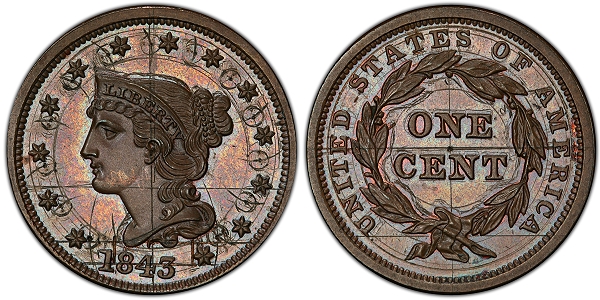
The 1843 Mature Head Design Model
The modifications take the form of a slew of lines, circles, and small indents etched into the surface, many of which appear to closely mimic or reference the design of the underlying coin, retracing the outlines of the devices and interspersing them within grid-like circles of varying size.
Of note are several small circles located at consistent distances along the obverse perimeter; a rectangular set of lines mapped out below the portrait; a slight retracing of the portrait itself above and to the left of the original; and similar retracings of the lettering and wreath upon the reverse. Upon the areas of the surface untouched by needle or blade there is a distinct dearth of damage, the surfaces vacant of distracting handling marks or hairlines and decorated with a wholesome, pleasantly toned patina of originality.
The canvas for this handiwork is itself a rarity, an 1843 “Petite Head” Large Cent in the Proof-only Newcomb-14 variety. A mere 15 to 20 proof cents are estimated to have been produced during this year, and as such, it would be bizarre and tragic for one of those few to be the subject of such severe alterations as the above piece appears to display.
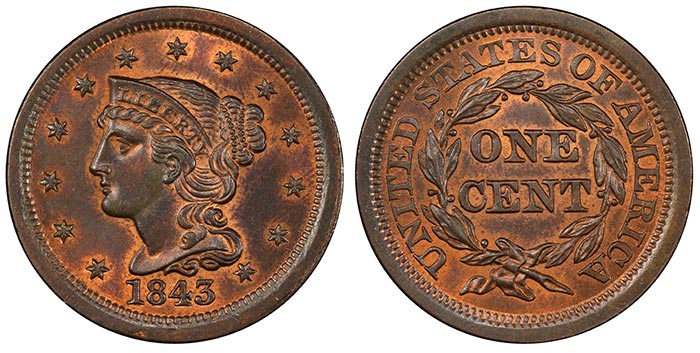
The collector well versed in the copper coinage of this period may be aware that sometime during the year 1843, a significant change was made to the design of the Petite Head type in the Braided Hair cent family; namely, the obverse portrait was widened slightly and rotated in respect to the date and stars, while the reverse lettering was enlarged and the wreath moved slightly inward. This new design, commonly referred to as the “Mature Head” type (Fig. 1), would be used on hubs for the remainder of the series until the discontinuation of the denominational type in 1857 in favor of a smaller planchet.
It is this transition that is of vital importance to the identification and significance of our piece.
Looking back at our engraved cent, it is evident that a simple compass and straightedge were used to carve into the coin’s surface. In the very center of each of the many circular engravings, there is an indented point, the remnant of the burrowing of a compass into the surface of the metal as the engraver traced its blade upon the face of the coin. Additionally, bisecting the center of each of the small engraved circles located around the perimeter of the obverse is a sort of curved arc. This would indicate that the engraver used a compass held at a fixed length and proceeded clockwise, as evidenced by the corresponding clockwise rotation of these arcs, around the obverse to measure and mark the positions of these circles.
Below (Fig. 2) we find an interesting overlay of the two aforementioned types: our own engraved Petite Head coin layered atop an example of the Mature Head type of the same date, the latter rendered in sepia so as to better distinguish the devices.
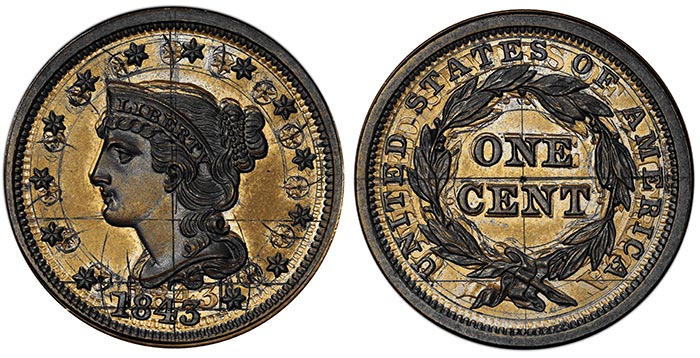
Several details of the two pieces appear to align exceptionally well when overlaid as such. Most notably, the 13 obverse stars upon the Mature Head cent may be found neatly arranged within several corresponding circular engravings upon the proof Petite Head coin, and the date on the Mature Head example appears similarly situated within an engraved rectangular border. On the reverse, the enlarged and relocated “UNITED STATES OF AMERICA” text on the Mature Head example also fits well within two engraved circular grid lines.
In Fig. 3 below, some basic elements of the engraved detail have been traced and the tracing overlaid as a whole directly upon the Mature Head example. Without the devices of the engraved cent obstructing our view, it becomes immediately apparent that most of the engraved material lines up remarkably well with the devices of the Mature Head type. In addition to the similarities mentioned prior, the upper and lower left areas of the portrait are closely outlined by the tracing, and the stars as a whole fit neatly within two circular traced grid lines, uniformly bisected by a third.
Additionally, the reverse wreath is situated within its own set of circular grid lines, and the beading upon each face aligns with an outermost engraved circle. Thus it would appear that the engraved detail on our Proof Petite Head specimen is in some manner representative of the Mature Head design that would appear on coinage beginning in 1843.
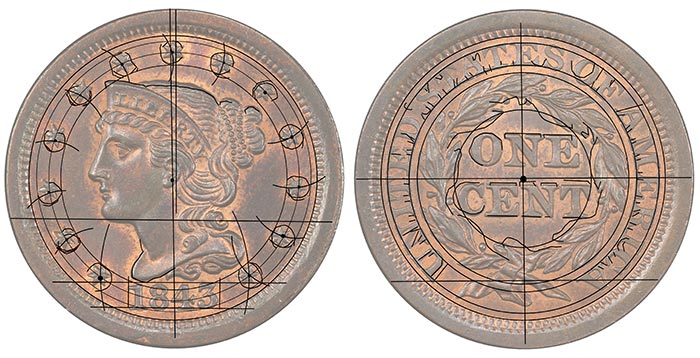
There are at least three things to keep in mind when looking at these overlays.
First, the engraving was done by hand with basic tools. So even though they were performed professionally, there are by necessity mild discrepancies between the designs; the engraved circles, for instance, are sometimes slightly ovoid, imperceptibly so but just enough that the central indented points are not always within their direct centers. The small circles denoting the star locations are especially clumsy; it is quite difficult to accurately engrave very small circles using a compass, as the needle tends to catch on the surface or slip due to an unequal distribution of pressure.
Second, as these images are magnified to extreme size, many apparent inconsistencies of design are in truth matters of a millimeter or less. There is also the consideration that no two dies are identical, and when we choose a Mature Head to make the comparison, we are not choosing a mathematically perfect representation of that design but one that may have subtle quirks in terms of rim size, beading length, date location, et cetera.
Third, the images we have utilized may themselves exhibit slight distortion due to parallax.
That being said, it is evident that, though minor, there are indeed disparities present between the designs, particularly on the reverse, that do not appear to be the result of mere human error – especially when juxtaposed with the relative consistency and precision of the obverse engravings.
For instance, in the final Mature Head design, the engraved “UNITED STATES OF AMERICA” lettering differs considerably from that upon the final design, commencing at about the same point upon the face but concluding nearly a full letter apart from one another. This difference can also be easily observed by the location of the “E” in “STATES”; in the final design it is directly above and parallel to “ONE”, but in the engraving it is off to the left. The reason for this particular discrepancy seems to be that on the engraved coin, the width of the lettering has not increased whatsoever, whereas in the final design it has. Perhaps this is simply due to the engraved lettering being a rough approximation, or perhaps the spacing and larger serifs that would eventually appear upon the Mature Head issue were not yet realized.
Such subtle differences are far from unfortunate or concerning. They serve to inform us that the final stage of the design process for the Mature Head type had not yet been reached at the time of the engraving of this piece and as such provides additional support for the notion that the piece was engraved prior to the creation of the master hubs rather than the work of a later artist. They also indicate that the engraving was potentially a basic layout of the proposed design, to be revised later if necessary.
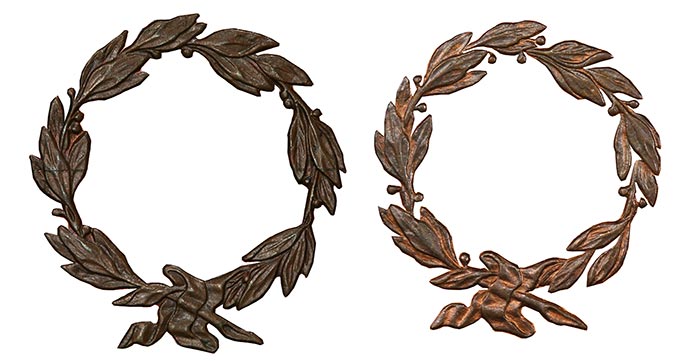
Indeed, a closer look at the differences between the engraved wreath and the final design gives us a clear idea of when in the design process the engraving of this piece took place.
Looking at a side-by-side scale depiction of the Petite Head and Mature Head wreaths (Fig. 4), we find that the wreath on the Mature Head is not simply a rescaling or adjustment of that on the Petite Head but rather that it has been completely re-engraved. A number of berries appear on the Mature Head that do not appear on the Petite Head. Many of the leaves are arranged differently. The ribbon is moved slightly to the left.
One attribute that remains relatively constant between the two wreaths, however, despite the shrinkage of the design overall, is the size of the ribbon and the individual leaves themselves. From this, it may be hypothesized that the wreath was resized in order to accommodate for the larger reverse lettering, but upon resizing the leaves and ribbon appeared too small and unappealing. Thus, the engraver decided to re-engrave the wreath entirely in order to avoid such an aesthetic catastrophe while still allowing for a smaller overall diameter. While re-engraving the wreath, berries were added and various other attributes altered in order to improve the overall appearance. The slight movement of the ribbon to the left, for example, allows for it to be centered within the now-enlarged perimeter lettering.
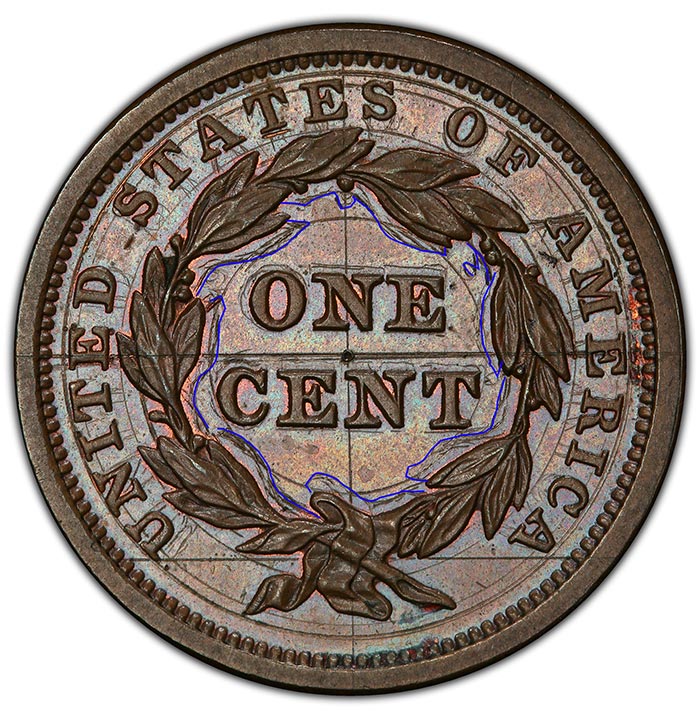
When we look at the engraved outline of the wreath (Fig. 5), however, we find that it echoes the design of that upon the original Petite Head. There are no extra berries as on the Mature Head, and the leaves and ribbon are in the exact same positions as they appear on the Petite Head. This indicates that the creation of this engraving may have taken place early on in the design process, prior to the decision to re-engrave the wreath. It should be noted here that the Petite Head wreath, and by extension the engraved wreath, closely matches that upon the Braided Hair half cent, which debuted in 1840 as a Proof-only type. This half cent type (Fig. 6), though more closely mimicking the Petite Head in terms of the wreath and portrait design[2], exhibits the larger reverse lettering and the rotated positioning of the stars and date relative to the bust that would eventually appear upon the Mature Head type.
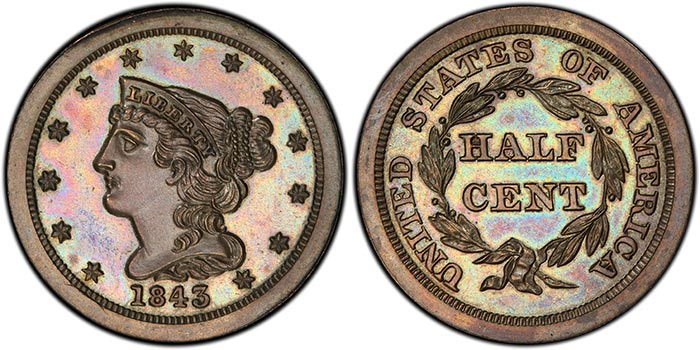
There is another key difference between the Petite Head and Mature Head designs that involves a complete re-engraving of the dies rather than a simple rotation or rescaling of certain design elements (which could instead be transferred to the dies via Contamin pantograph[3]): the obverse portrait.
There is more than one observable disparity between the two portraits, but the most apparent is located at the top of the portrait, where the upper hair curl meets the coronet (Fig. 7). As you may observe, the curl is quite flat overall upon the Petite Head and half cent types, as well as in the engraved outline, and meets the coronet above the right-hand side of the “I” in LIBERTY.

On the Mature Head portrait, however, there is much more of an upward curve to the curl and it meets the coronet above and to the left of the “I”. Thus it would seem that the engraved design, in all the areas that would eventually be re-engraved and not merely repositioned–the wreath, the reverse lettering, and the portrait–matches more closely with the corresponding areas upon the Petite Head type than with those upon the final Mature Head issue, with the changes in positioning corresponding with that apparent upon the half cent. As such, it seems logical that the creation of this engraving may very well have been one of the first steps by Gobrecht in the design process of what would eventually become the Mature Head cent, perhaps as a rudimentary recreation of the original design using the altered positioning apparent on the Braided Hair half cent.
Engraver and Purpose
Now that we have established that this piece was almost unquestionably engraved prior to the development of the final design of the Mature Head type, and thus by nature during the year 1843, two glaring questions remain: who was the engraver, and why was this piece engraved?
We have so far assumed that Christian Gobrecht was the artist, given that he was the Chief Engraver at the United States Mint during this year and is generally accepted as the designer of both the Petite Head and Mature Head types.
But to address these inquiries further, we must first examine the known processes surrounding the production of coinage in this period.
The methods of production employed by the Mint in the early 1840s were, in a basic sense, much the same as they would remain until the introduction of modern computerization to the minting process. Cent planchets were purchased from suppliers, and the edges were compressed into rims using a milling machine. After being cleaned and treated, the planchets were transferred to a steam-powered press, where, placed within a steel collar, they would be struck between an obverse die and a reverse die to create the final coin.
The dies themselves were the product of a long process.
First, a master die was prepared in softened steel. This preparation could take the form of hand-engraving of the design, of transference of the design to the die via the use of a Contamin pantograph, or of imprinting the die with punches containing certain design elements, such as a portrait, a wreath, lettering, or an array of stars.
After the master die hardened, it was used to impress a steel hub, which in turn was used to impress multiple steel dies, to be used to strike the coins themselves[4].
As a final step prior to their usage, these coin dies would be imprinted with a date punch.
The processes occurring prior to the creation of the master die, however, remain fairly indeterminate. Contemporary documentation surrounding the designing of coinage and development of pattern issues in this period is nearly nonexistent, in part because such procedures were unique to the styles of individual engravers and generally were kept private even between Mint officials. As a result, we retain very little physical evidence of the precise methods Gobrecht may have employed in the creation of new coinage during his time at the Philadelphia Mint.
Thus when confronted with a piece such as the one before us, we can only surmise whether such an operation was routine for the development of remodeled coinage, perhaps as a trick Gobrecht adopted from Chief Engraver William Kneass, or if this was the singular instance of its application. It is not inconceivable that during previous numismatic design changes or as part of his standard design process Gobrecht may have made use of this same technique, but that any such engraved pieces were consequently lost or destroyed.
In fact, the sole piece of correspondence I have been able to uncover regarding any engraving or diesinking work performed at the Mint in 1843, of any denomination of coinage, is a letter from Gobrecht to Director Robert M. Patterson in November of that year, relating that “the weather being disagreeable this morning, I shall not come to the Mint. Enclosed I send the key of my drawer, in which you will find two half dollar tail dies, which, if intended for our Mint, are finished – one pair half eagle dies, and one pair turned half dollar dies, not finished. Having brought home with me yesterday the date punches, I am fully prepared to finish the last named dies, if they are wanted.”[5]
So at the very least, we do have evidence that Gobrecht was performing diesinking work in 1843, even if it was simply adding dates to unfinished dies (though his mention of the two “tail” half dollar dies would seem to indicate that he was adding hand-engraved finishing touches to the dies as well since the date is not located on the reverse and he states that they are finished “if intended for our Mint”; i.e., they were not given mintmarks).
Well, one might ask, what of the possibility that this piece was produced by a secondary or assistant engraver at the Mint? In a letter dated August 28ᵗʰ, 1840, one day after the death of Kneass, Patterson details the following to President Martin Van Buren, regarding the appointment of a replacement for the newly vacant position:
I recommend, very respectfully, but without hesitation, that the vacant office should be supplied by the appointment of Christian F. Gobrecht, who is the present Assistant Engraver, and has filled this place for four years. Mr. Gobrecht is an artist of great skill and industry, and, in consequence of the low state of health of Mr. Kneass, has, for a long time, performed nearly all the duties of Engraver. His personal character is altogether unexceptionable.
If this appointment be made, I think it will not be necessary or expedient to supply the place of Assistant Engraver; — as our improvements in the mechanical means of multiplying dies have greatly diminished the labor formerly required of the Engraver.[6]
In an accompanying letter of this date, addressed to Levi Woodbury, Secretary of the Treasury, Patterson again stresses that “the whole duties can now be performed by one engraver, with the aid of an able mechanician, Mr. [Joseph] Saxton, already in our employment . . .”[7]
Evidently, Patterson felt at this time that given the capabilities Gobrecht had demonstrated over the course of his employment, it would not be unsuitable to entrust him solely with the engraving duties. Due to the expressed lack of desire for a secondary engraver (and lack of any mention of a secondary engraver in the 1843 Register of all Officers and Agents[8]), if our cent was indeed engraved at the Philadelphia Mint–which I have no doubt of–then realistically the only possible artist would be Gobrecht himself. Designating the task to another employee would be not only impractical but probably impossible. If we are to accept that Gobrecht was the engraver of the Mature Head design as a whole, as we very safely may, then there would seem no other culprit for the engraving of our model.
Now as discussed, this piece was demonstrably engraved by hand. Yet despite its crude manner, it is executed professionally, purposefully, and with the utmost attention to detail and precision. When a mistake is made, it is re-engraved in the correct position. For instance, on the obverse, to the left of nearly every engraved circular “star”, there exists the faint remnant of a similar circle from what would appear to be an original mismeasurement of their proper locations, and down near the area of the rectangular grid lines indicating the placement of the new date, there are a few botched lines where the engraver evidently miscalculated and corrected himself. Also of note is that for the most part, the details of the design have been etched quite deeply into the surface, the result of careful retracings of the blade over the engraved areas. This surgery was likely performed after the entire design was engraved, as the “mistakes” generally do not exhibit such depth.
Due to this piece demonstrating evidence of measurements performed directly on the surface of the coin itself (the grid lines and compass marks), as well as of apparent miscalculations and re-engravings, it may be inferred that the engraving was not traced onto the surface using the aid of a design printed on paper, but rather that the design was laid out on the coin using the coin itself as a template.
Why would this be the case? Why use a struck coin as a model for laying out a fresh design?
Well, given that the Mature Head is, in its most basic form, a rotated, adjusted, and resized version of the earlier Petite Head issue, it is easy to see why engraving the design upon a struck piece would serve as a useful comparison of the proposed and existing types, and as a convenient visual aid for the process of finalizing the new design and creating the master hubs. This hypothesis is reinforced by the fact that the engraver had the foresight and care to center his compass upon the coin using the beaded rims as a reference, rather than using the edges of the planchet itself. The latter choice, though the simplest to perform, would have proved unfortunate for the purpose of presenting a juxtaposition of the engravings and the struck devices, as the obverse of the piece is positioned mildly off-center within the rims and thus there would be two distinct central points. Thus, we cannot simply write off this piece as a sort of sketch of the new design, indistinguishable from one done on paper except in terms of the medium. Rather, there was clearly a reason for using a coin, and a struck coin at that, for the purposes of this project. Additionally, such care and planning must be attributed to an engraver with ample experience in his craft.
Indeed, it may be surmised that this piece would have been presented by Gobrecht to Mint Director Robert Patterson as a rendering of his proposed design changes to the cent, essentially functioning as a struck pattern is intended to; as director, Patterson would have been tasked with the approval of any changes to the design of United States coinage, and perhaps the alterations to the wreath, lettering, and portrait made upon the cent following the production of this engraving were the result of decisions arrived upon by Patterson or Gobrecht during such a presentation. Laying out the new design in this somewhat crudely engraved manner would limit the necessary expenditure of time and energy towards the engraving of an actual pattern die, while at the same time supplying a direct comparison to the design present upon the older style. Since the differences between the Petite Head and the engraved design are in essence minor modifications to size and rotation, a mere sketch on paper of the proposed design would not suffice for a proper depiction of the suggested changes, as they would not be clearly distinguishable without an on-hand comparison.
Using a Proof cent as a canvas for this engraving would be ideal for the purposes of such a juxtaposition, as the struck detail of a Proof is sharp, defined, and complete. allowing for a more precise template. Aesthetically, Proofs also serve as an optimal medium for the intent of display or presentation, if this was the intended purpose.
Even for a Proof, this piece has an admirably strong strike, especially given that some examples of the date are found with quite soft impressions by comparison. The stars are crisp and full, the denticles bold and even, with no evidence of weakness throughout the entirety of the design; in fact, I would opine that the level of detail exhibited by this piece is rivaled by only that of the very finest known Proofs of the date. It was struck with such strength that stars nine through eleven on the obverse exhibit noticeable doubling and even tripling from the die or planchet vibrating slightly during the strike (Fig. 8), a characteristic not found on other Proof examples of the date to my knowledge; strike doubling upon Proofs dated prior to 1858 is quite uncommon.

Given this disparity in strike quality, it may be inferred that the piece was struck expressly for the purpose of this engraving, a hypothesis that would seem to make the most sense, as there are few other likely scenarios in which a proof example would end up in the hands of the chief engraver.
On the other hand, perhaps the piece was recalled by the Mint because of the aforementioned strike doubling or for an unknown reason, and Gobrecht decided to make use of what would otherwise be a wasted coin. It is difficult to determine exactly what qualities the mint considered to be unacceptable on the Proof coinage of this period, especially given the softness of the strike on other extant Proofs, so perhaps a definite conclusion cannot be drawn.
Categorization
Here the problem arises as to how best to categorize this piece within our commonly used numismatic terms.
Stylistically, the engraved model is somewhat reminiscent of the grid-like composition of the Judd-A1836-4 (1836) white metal Gobrecht dollar splasher, in that it provides a measured layout for aligning the proposed design, but in truth, there would appear to be virtually no suitable comparables throughout the field of American numismatics (though there is one coin dating from very early on in the history of the United States Mint that is quite similar in concept and execution to the present piece, but, as research is still being performed upon that piece, I am not at liberty to discuss it further).
The proposed issues, or patterns, that we know of today present complete, struck representations rather than layouts engraved upon entirely distinct struck coins. Indeed, patterns that display mint-made hand-engraved design elements are far from commonplace; the sole other documented type may be the 1849 Judd-115/116 gold dollar patterns, which were hand-engraved by Chief Engraver James Longacre. Though the intent of the creation of these pieces is similar to ours, having been produced as representations of a proposed type, these pieces have been designated as true patterns in the traditional sense as they are theorized to only have been hand-engraved due to a lack of time, and moreover, because they exhibit a full, completed design layout.
One might argue that because our piece does not offer a finalized design (for instance, the stars are not truly stars, but circles representing where the stars would potentially be situated), it cannot justifiably be called a “pattern” in the traditional sense. However, I would maintain that it does truly belong under the larger “pattern” group classification. It is not merely a sketch that happens to be engraved upon a coin, but a precisely detailed layout of a proposed design engraved with intent upon a Proof coin that was quite possibly struck expressly for this purpose. If one is to favor the theory that this piece was utilized by Gobrecht as a presentation of his proposed design to Patterson, then it would seem no less a pattern than the 1849 Judd-115/116 gold dollars.
But for a more specific and precise term, the aptest title seems to be something along the lines of “Engraved Design Model”, placing it within its own category in the numismatic field. It certainly cannot be categorized as one of the other various terms sometimes grouped together with patterns: die trials, hub trials, or splashers.
Provenance
When met with a piece such as this (not that such things occur frequently), one of the first questions one must attempt to answer is, “When could this have been created?” In the face of what we have so far observed and discussed about the piece, and armed with the knowledge that it would be senseless to damage a Proof coin so rare as this and in so convoluted a fashion, even the consideration of inauthenticity or of a modern engraving might seem absurd. Even so, it is important nonetheless to diligently examine this as a possibility.
Upon my purchase of the piece, I knew only that it had been sold by John R. Frankenfield to Robert E. Matthews on January 7ᵗʰ, 1990 (I assume at the Florida United Numismatists convention, which took place from the fourth to the seventh of January in that year), and had remained in the Matthews collection and estate until my acquisition.
For a while, tracing it beyond 1990 seemed futile, as Frankenfield and Matthews had both passed on and my leads seemed exhausted, but I eventually found a reference to the piece in a 2010 Penny-Wise catalogue[9], (itself drawn from an earlier 1992 census, where the piece is additionally noted as graded “Net-20, Engraved”, by Bob Grellman[10]) that mentions “H-R 8/87:66” as a provenance. This led me to the 1987 Harmer Rooke Numismatists, Ltd. auction of the William Beaver Chamberlin collection, where this very piece is imaged as Lot 66 and realized $1,540 USD including buyer’s premium. It is noted within the auction catalogue that Frankenfield assisted in the attribution of the piece.
William Beaver Chamberlin, the owner of this piece prior to Frankenfield, was a Philadelphia coal dealer born in Danville, Pennsylvania, on August 2, 1865, with an ancestry dating back to 17th-century New England. Chamberlin was a collector of Large Cents by date and major variety and purportedly purchased them in full from the prominent Philadelphia coin dealer, Joseph Colvin Randall, Jr. from 1891 to roughly 1901. In this era, late-date Large Cents had not yet been broken down into great detail by individual die variety, and 1843 cents in particular were mainly grouped by the basic varieties that we now call the Petite Head with Small Letters, Petite Head with Large Letters (a mismatching of one of the new Mature Head reverse dies with one of the leftover Petite Head obverses), and Mature Head[11], the present coin occupying the 1843 Petite Head, Small Letters spot in Chamberlin’s collection.
Chamberlin ceased collecting Large Cents upon Randall’s death in 1901, and following his own passing in 1942, these coins remained in the hands of his heirs until they were put to auction in 1987.
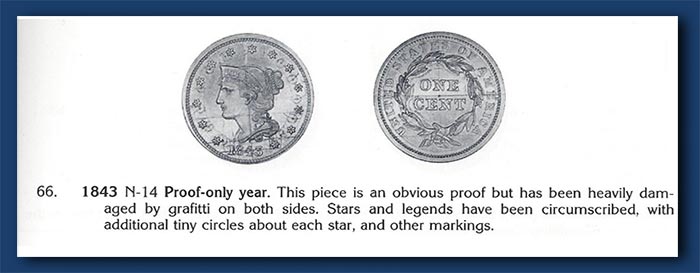
Frankenfield, unlike Chamberlin, desired to collect not only one of each of the known die varieties but the finest examples of each that he could find. Thus, the present piece was only a placeholder for the rare Proof-only Newcomb-14 variety of the date, until he eventually purchased a finer example from the March 1988 auction of the Herman Halpern collection by Stack’s. In 1990 he sold the engraved coin to Matthews, who was more concerned with acquiring a complete variety collection than the finest available example of each, and in 1992 it would be listed in a late-date Proof Large Cent census in Penny-Wise, where it was viewed in hand and graded as Net-20, engraved, by Bob Grellman.
Now, Joseph Colvin Randall, Jr. (1832–1901), as a prestigious coin dealer who happened to reside in Philadelphia his entire life, had direct access to the Philadelphia Mint and purchased Proof coinage directly from the Mint from his youth onward, owning numerous famed rarities over the course of his life and amounting what is now the core Proof gold collection of the American Numismatic Society. If we are to assume that Chamberlin purchased this piece from Randall, which seems probable, it becomes many times more likely that it is a Gobrecht artifact, as Randall may very well have acquired it himself directly from the Mint. It certainly cannot have strayed far from the Mint before ending up in the hands of either Randall or Chamberlin, both of whom were located nearby.
In any case, it would at the very least seem to be the case that prior to my acquisition of the piece, it had seen the hands of only three other owners in over one hundred years, in at least two cases (Chamberlin and Matthews) selling in estate sales posthumously — a claim that the superb surface condition of the coin can attest to, despite it having remained free of any slabs until very recently.
Conclusion
The question arises: Why would such a piece survive? There would seem to be no truly comparable pieces in the field of American numismatics, so possibly such items, if a standard component of Gobrecht’s design process, were not meant to leave the Mint; these processes were kept private even between Mint officials, which is part of the reason why so little is known of them today.
One possibility is that the piece was passed on by Gobrecht to his heirs and eventually sold to a dealer. The likeliest theory, in my view, is that the Philadelphia Mint did not know what the coin was and eventually sold it to Randall or another dealer as a damaged Proof; as Gobrecht died only a year after this piece was struck, he may have left it behind at the Mint where its significance was not realized.
Undoubtedly there is more to unpack regarding this intriguing coin, and I am sure that additional information will come to light once it is revealed to the public eye.
It is possible that somewhere among the hundreds of thousands of pages of hand-written U.S. Mint correspondence from the 50-odd years between the striking of this piece and Chamberlin’s acquisition, there exists a note detailing the sale of an engraved Proof 1843 cent to Randall or another Philadelphia dealer. Perhaps Chamberlin’s or Randall’s purchase records lie hidden away in some library archive, waiting to be unearthed. Even as our understanding of it stands, however, the significance of this piece is unquestionable.
Given that it was, as we have established, engraved prior to the inception of the Mature Head design, it must have been struck in 1843, and given that it is engraved upon an example of the Newcomb-14 variety, this variety must be dated to 1843 as a whole and is not a restrike as some have suggested. Accordingly, this coin is the first piece of solid evidence regarding the exact date of issue of any of the Proof-only Braided Hair cent varieties, and at the very least solidifies that all Proof Large Cents dated 1843 were in fact struck within that year.
In addition, it is a source of rare insight into the opaque nature of the design processes employed by the still-new United States Mint, a form of pattern coin hailing from a span of nearly a decade in which pattern coins are essentially unknown, an incomparable example of a coin not simply struck by, but likely engraved by hand by none other than the great Christian Gobrecht himself.
And, finally, perhaps the sole piece of contemporary information regarding the timing and planning of the adoption of the Mature Head design.
* * *
Sources and Notes
[1] The infamous Walter Breen suggests (with no supporting evidence) that several such Proof-only varieties, including the 1843 N-14, were coined in 1850 upon the occasion of the visit of a French dignitary, Alexander Vattemare (see the July 1976 edition of Penny-Wise, Vol. X, p. 190).
[2] Eckberg, Bill. 2020. “The Large Cent Heads, 1796-1857”, Penny-Wise, Vol. LIV, pp. 4-11.
[3] A machine used to trace three-dimensional designs from one surface and re-engrave them upon another, introduced to the United States Mint by employee Franklin Peale in 1836 after a visit to the Paris Mint. A lovely description of the function and operation of the Contamin pantograph at the Mint appears in the December 1861 to May 1862 edition of Harper’s New Monthly Magazine (Vol. 24, Issue 139, New York: Harper & Brothers, Publishers, 1862, pp. 23-24), therein referred to as a transfer or reducing lathe.
[4] Eckfeldt, Jacob R.; DuBois, William E.; Saxton, Joseph. A Manual of Gold and Silver Coins of All Nations, Struck Within the Past Century, pp. 13-14. Philadelphia, Pennsylvania: Assay Office of the United States Mint, 1842.
[5] National Archives, RG 104: Inventory Entry 1 – General Correspondence, Box 22, p. 408.
[6] National Archives, RG 104: Inventory Entry 216 – Branch Mint Correspondence, Vol. 5, No. 84.
[7] National Archives, RG 104: Inventory Entry 216 – Branch Mint Correspondence, Vol. 5, No. 82.
[8] Register of All Officers and Agents, Civil, Military, and Naval, in the Service of the United States …: 1843. Department of State.
[9] Loring, Denis. 2010. “Late Date Proof Census, Part 1 (1840-1844)”, Penny-Wise, Vol. XLIV, pp. 198-205.
[10] Loring, Denis. 1992. “United States Proof Large Cents, Part 2 (1840-1857)”, Penny-Wise, Vol. XXVI, pp. 4-22.
[11] Andrews, Frank D. 1883. An Arrangement of United States Copper Cents, 1816-1857, for the Assistance of Collectors, p. 30.
* * *
Special thanks to Roger Burdette, John Dannreuther, Bill Eckberg, Bob Grellman, Craig Sholley, and Saul Teichman for lending me their time, energy, and expertise over the course of my research, and to the good folks at the /r/Coins Discord channel for their aid in the original identification of this piece.


